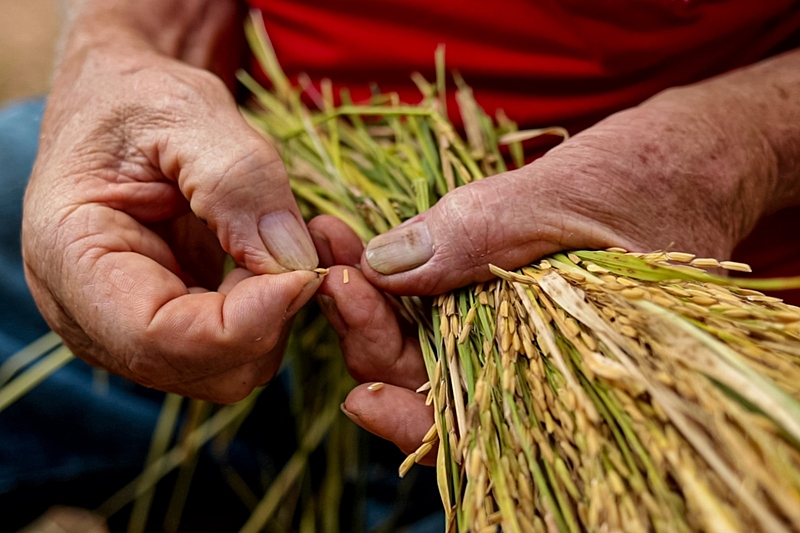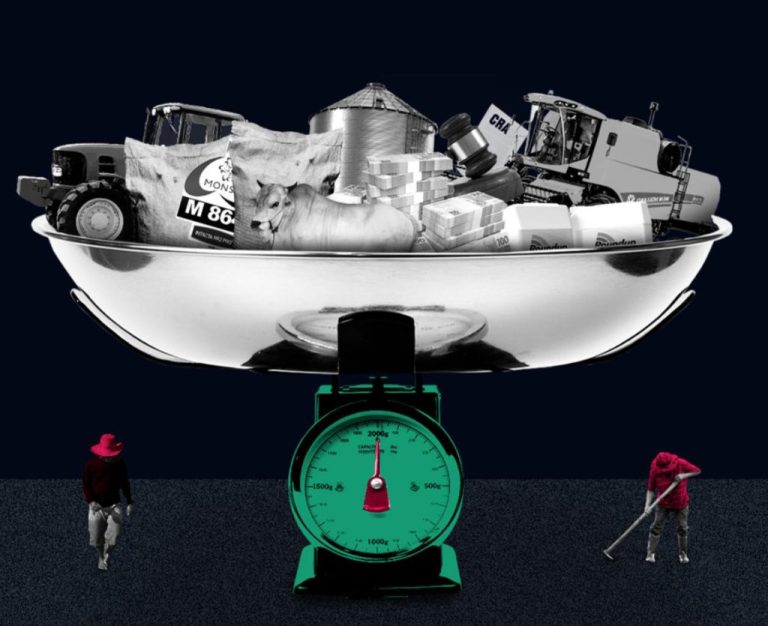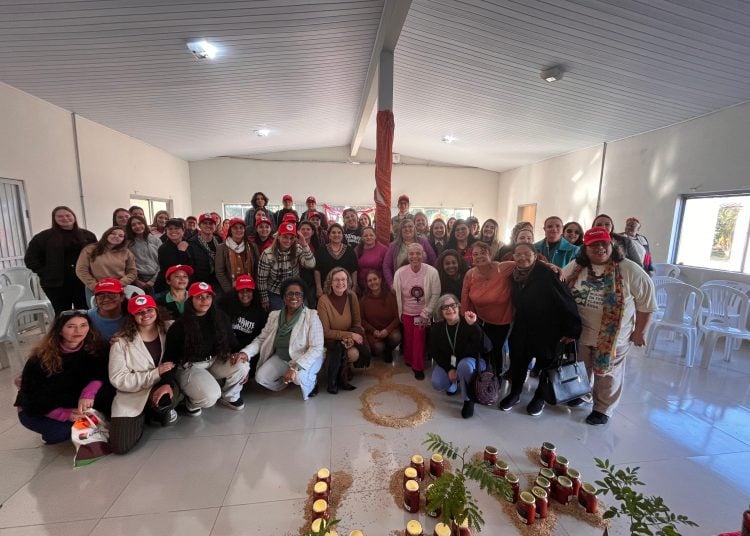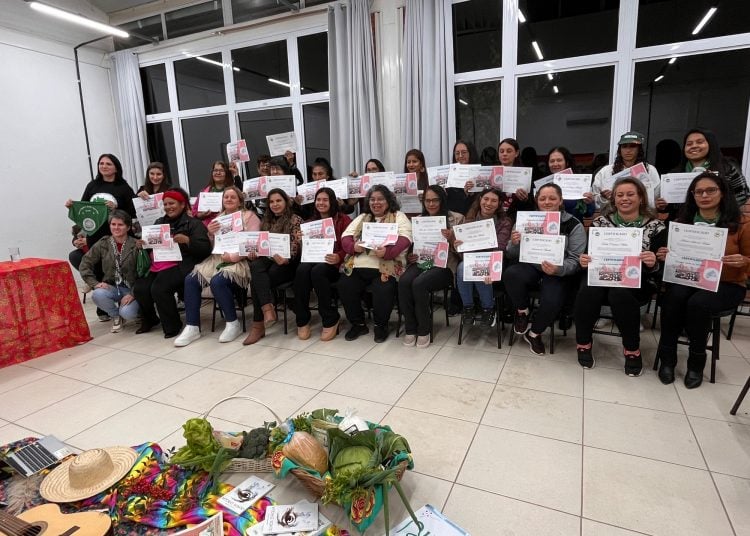Organic rice from MST crops: agroecology can produce on a large scale and oppose agribusiness
Using no pesticides and chemical fertilizers, movement bets on bioinputs and community management to expand production

By Rodrigo Chagas e Pedro Stropasolas
From Brasil de Fato | Viamão (RS)
It doesn’t take poison or forced labor to eliminate weeds. It is possible, for example, to manage more adequately the water flowing through the kilometers of pipelines that irrigate the plantation of needle rice – or cateto rice. Neither are chemical fertilizers necessary to increase land productivity. It is possible to recover ancestral knowledge and organize mass production in a bioinput factory, which is neither toxic nor polluting.
For more than two decades, the farming families of the Landless Rural Workers Movement (MST) in Brazil have insisted on the mission of producing organic rice, balancing income generation with respect for the environment. The pioneers had to develop their own cultivation method and compete for space with agribusiness and its way of planting. And they did it.
MST agroecological rice gained prominence in the political debate by appearing, according to the Rio Grandense Rice Institute (Irga), as the largest organic production in Latin America. Thanks to the knowledge accumulated by the farmers themselves – and with some help from universities and local public organizations – both the planted area and total production are growing, even in the face of a shrinking national rice production in Brazil.
“Agribusiness asks: ‘How can you produce rice without poison and without chemical fertilizers?’. We reply: ‘come and meet us!’. We use nature itself to give us what we need,” says agricultural technician Ivan Carlos Prado Pereira, son of agrarian reform settlers and an organic rice producer since 2010.
At the 20th Agroecological Rice Harvest Festival, held in March this year at the Filhos de Sepé Settlement, in Viamão (Rio Grande do Sul State), the movement celebrated the production longevity and presented news, such as the inauguration of a bioinput factory and the implementation of a participatory organic certification process.
According to Roberta Coimbra, from the production sector of the MST in Rio Grande do Sul, innovations in the production chain seek to generate autonomy for farming families, creating viable alternatives to the so-called “conventional planting”, in which pesticides and chemical fertilizers produced by large industries are used.
“The farmer in this scenario never has autonomy and is always at the mercy of the price game played by these large corporations”, explains the settler.
With the proposal of agroecology, in addition to recovering the lands worn down by agribusiness where settlements are normally established, the MST, argues Coimbra, seeks to involve the entire settled community in the different stages of production – “planning, cooperatives, agroindustry, commercialization and certification, which is being this instrument of involving families directly in production, in the field”.
“Rice production, being mechanized, is sometimes seen as a production for men only. But we have room for everyone and we can involve youth and women in rice production”, she emphasizes.

Where it all began
The Filhos de Sepé Settlement, where half of the agroecological rice planted area in the state is located, brings together some of the pioneers who started production in the early 2000s. The first harvest festival was held there, in 2003.
Leonildo Zang is one of those pioneers in the cultivation of rice with no use of poisons and chemical fertilizers.“It was our initiative. And we ourselves began to study. How to plant, how to learn to plant organically”, recalls Leonildo, now 70 years old, who says he participated in the first MST Congress, in 1985, before becoming encamped, and later settled, by the movement.
I’ve been a victim of agribusiness, I’ve been a victim of poison. I went camping for that reason, I didn’t submit to planting tobacco with poison. In agroecology it is different. If we are here breathing oxygen, we also need to produce oxygen. We need to take care of nature. We need to take care of the whole cycle. If not, we will live without breathing, without having healthy water. All this has to be taken care of, right? It’s not just about profit.
Zang has lived in the settlement for 24 years and has seen agreocology win the dispute with the agribusiness model. Settled families and organic production coexist with native species from the springs, dams and water courses of the Banhado dos Pachecos Wildlife Refuge, part of the Banhado Grande Environmental Protection Area.
Due to an intervention by the Brazilian Federal Public Ministry (MPF), and the successful experience of some of the settlers who, from the beginning, opted for agroecology, the use of pesticides is prohibited throughout the entire settlement. Prior to that, poison and non-poison crops coexisted for about a decade.

For the settler Marthin Zang, son of the pioneer Leonildo and researcher at the Federal University of Rio Grande do Sul (UFRGS), the settlement became a reference in three main landmarks. By producing rice on a large scale and “opposing the discourse that agroecology does not feed humanity”. By organizing community management – “and not individual” – of the water resources used in the plantation. And for associating the production and water management to the “larger context of environmental preservation”.
“Production is not antagonistic to conservation as long as they coexist and we can look at indicators that go beyond productivity”, explains Marthin. “We are not just producing food: the agroecology project produces life”, explains the father, Leonildo Zang.
The blow of the coup interrupted growth
Public policies aimed at agroecology and family farming were discontinued or defunded in Brazil, mainly after the coup against Dilma Rousseff (Workers’ Party) in 2016 and the arrival of Michel Temer (Brazilian Democratic Movement Party) to power.
The Food Acquisition Program (PAA), which had investments of R$1.3 billion in 2012 (approximately US$263 million), has shrunk to R$135 million in 2021 (approximately $25 million). The National Program for Strengthening Family Agriculture (Pronaf) and the National School Feeding Program (Pnae) also suffered budget cuts.
Without being able to count on public policies for the disposal of production, a part of the organic rice harvested ended up going to the “mass grave”, that is, sold at the same price of conventional rice, or below that, says Ivan Carlos Prado Pereira, the president of the Residents Association of the Filhos de Sepé Settlement.
“The appreciation of our product and respect for agroecological production were abandoned”, reports the farmer, mentioning the priority given by these programs to the acquisition of organic products coming from family farming.
“We suffered a lot with this, having to look for the conventional market, the supermarket, or the wholesale market to try to sell our product”, corroborates Mirian Manfron, president of the Nova Santa Rita Agricultural Production Cooperative (Copan), established in the Capela Settlement, responsible for 300 hectares of agroecological rice cultivation.
The downfall was due to the fact that 80% of what the cooperative sells is destined for school lunches. “We prioritize food on children’s plates, right? We always try to provide this life, this healthy food, and fight for these public policies, but they are not always implemented the way we want.”
In the context of uncertainties, many stopped planting organic, and the area planted with agroecological rice reduced drastically, but has been recovering year after year (see infographic above).
“Our biggest challenge is to maintain production, to keep our territory free from pesticides, free from transgenics”, asserts Ivan Pereira, in view of the advance of agribusiness. “We lost many areas because there is agribusiness nearby putting poison on top of production, killing animals, insects, killing everything.”
The attack by agribusiness over the last four years has been very strong. Our challenge is to gradually increase and recover the areas that agribusiness has taken from our organic production. And with that, make the government criminalize those who use poison over the areas.
Public policies and youth involvement
The MST concentrated its mobilization force on the electoral campaign and, from the presidency of Luiz Inácio Lula da Silva (Workers’ Party), expects the resumption of agrarian reform with a focus on policies to strengthen agroecology.
The Cooperative of Settled Workers in the Porto Alegre Region (Cootap) is MST’s largest rice producer and expects to increase the planted area by 25% for the next harvest.
Farmer Nelson Krupinski, president of the cooperative and member of the Agroecological Rice Management Group says that the resumption of public policies should facilitate rice commercialization.“With bigger sales, the demand increases. So we need to offer more rice. And that implies involving new families, new areas, including new settlements.”
The challenges of difficult times also provoked the movement to innovate as a way forward. The protagonism of women and youth and the modernization of production draw attention.
The president of Copan, Mirian Mafron, was born in the same year the cooperative was founded, in 1995, and joined at the age of 16. “As a young person, it is difficult to stay in the countryside, which is why we often end up losing young people to agribusiness or to other networks”, considers the settler.
“It’s a victory to stay here and fight for these principles that are those of our parents and friends”, she gets emotional.

Copan’s agroindustry, in Nova Santa Rita, is one of three in the MST production system, which has physical structures for receiving, drying and storing grains and machinery for product quality control and grain processing. In the photos above, an aerial view of the place and the rice receiving and packaging processes.
Modernization and focus on productivity
Agribusiness is planting soybeans where rice used to be planted. The high production costs and the “facilities” of soybeans have led farmers to switch crops. The planted area has been decreasing year after year, as well as that of beans and other favorite foods on the Brazilian table. The expectation is that this year’s harvest will be the smallest in 26 years, according to the National Supply Company (Conab).
The MST wants to propose an agroecological future for rice in Brazil. Without imported pesticides and chemical fertilizers on the bill, and with its own seed production, costs are lower. Water, land and workers do not become polluted, out of balance or sick.
And with the manufacture of bioinputs on a large scale, the movement points to a gain in productivity of the planted areas, with the recovery of the vitality of the land where the settlements are located, commonly devastated by agribusiness activities.

“Every farmer knows that when we have a strong soil, the crop does well. Now if we are on degraded land, where settlements are normally established, we need to make an effort to take care of the land, or else we will sink into debts related to chemical fertilizers, a lot of poison and that has no future for us”, explains Roberta Coimbra, from the MST production sector.
The president of Cootap, Nelson Krupinski, celebrates the improvement of production techniques in recent years, but recognizes the challenges that lie ahead, “on the subject of productivity, organic and biological management, also in industrialization, in machinery, in infrastructure for the settlers to produce in a more adequate way, in order to maximize what the soil has, what nature offers, the sun, the water”.
“We have great expectations with the government about resuming effective technical assistance in the settlements focused on agroecology, which serves us, to make a counterpoint to agribusiness, but also mainly to feed Brazilian society in a healthy way”, summarizes Krupinski.

Inaugurated during the 20th Agroecological Rice Harvest Festival, the movement’s first bioinput factory honors Ana Primavesi, who died in 2020. The agronomist is the greatest reference in soil studies within the field of agroecology. The “living soil” method, explains Roberta Coimbra, uses bioinputs “already known to science for many decades”. “What’s new is that farmers have this knowledge for themselves and produce these inputs based on bacteria, fungi, beneficial microorganisms that are in nature, and use them in our favor to improve soil quality.”
Nilvo Fernando Boza, one of the pioneers in agroecological rice production in the Capela Settlement, in Nova Santa Rita (Rio Grande do Sul state) believes that investments in new technologies and structure will raise MST production to new levels. But, based on the experience gained since 1999, he claims that planting without poison is already more profitable in all aspects, compared to agribusiness production.
“The organic product is worth a little more. Even if you produce a little less, you earn more and at a lower cost. In addition to being economically equivalent to conventional planting, for us there is another factor that is priceless, which is the environment, life, nature, which is the preservation of everything we preach”, he teaches.
For us, it’s a pleasure to be working, because working on a farm where everything is organic gives you quality of life. You are not applying pesticides, chemical fertilizers or fungicides, which is what other crops need. No, our crop is healthy. We didn’t go camping to gain land to live worse than we were. Our goal is to live better, with a better quality of life, and rice is an example of that.
Edited by: Raquel Setz
Translated by: Lucas Peresin

 I’ve been a victim of agribusiness, I’ve been a victim of poison. I went camping for that reason, I didn’t submit to planting tobacco with poison. In agroecology it is different. If we are here breathing oxygen, we also need to produce oxygen. We need to take care of nature. We need to take care of the whole cycle. If not, we will live without breathing, without having healthy water. All this has to be taken care of, right? It’s not just about profit.
I’ve been a victim of agribusiness, I’ve been a victim of poison. I went camping for that reason, I didn’t submit to planting tobacco with poison. In agroecology it is different. If we are here breathing oxygen, we also need to produce oxygen. We need to take care of nature. We need to take care of the whole cycle. If not, we will live without breathing, without having healthy water. All this has to be taken care of, right? It’s not just about profit.


